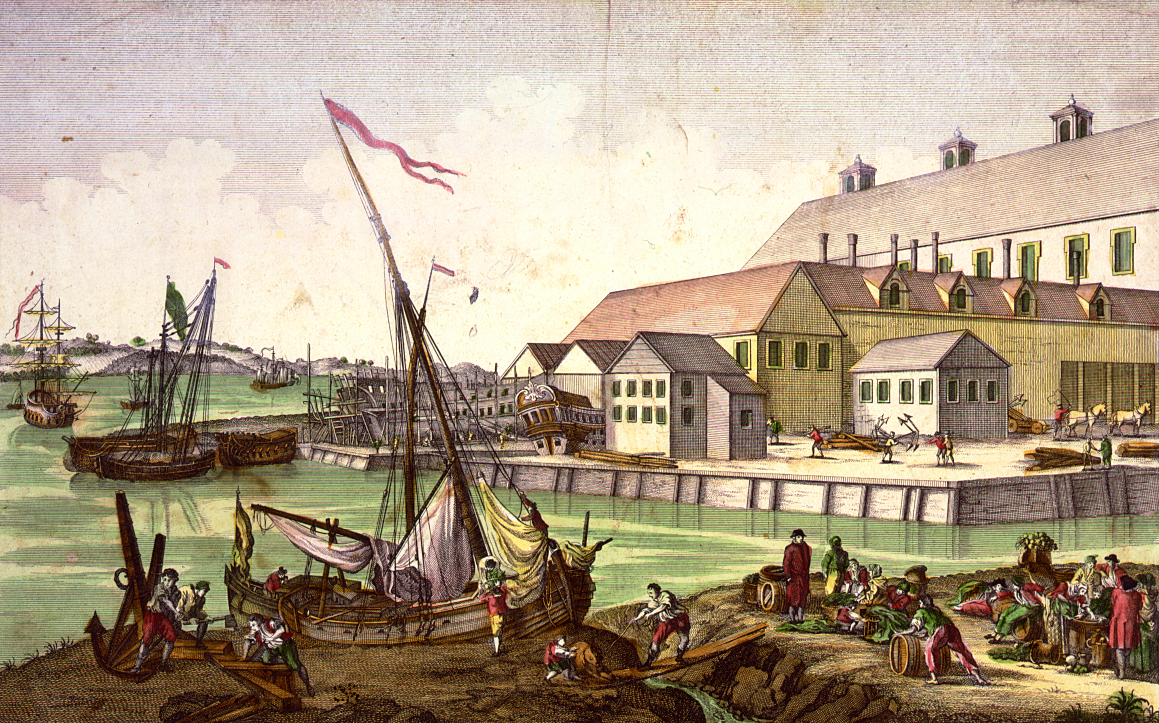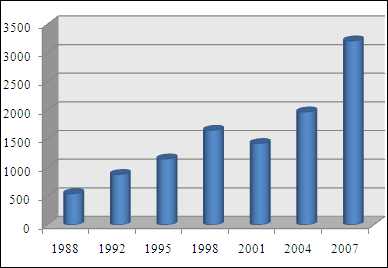|
Louvre Accord
The Louvre Accord (formally, the Statement of the G6 Finance Ministers and Central Bank Governors) was an agreement, signed on February 22, 1987, in Paris, that aimed to stabilize international currency markets and halt the continued decline of the US dollar after 1985 following the Plaza Accord. It was considered, from a relational international contract viewpoint, as a rational compromise solution between two ideal-type extremes of international monetary regimes: the perfectly flexible and the perfectly fixed exchange rates. The agreement was signed by Canada, France, West Germany, Japan, the United Kingdom, and the United States. The Italian government was invited to sign the agreement but declined. Background The Plaza Accord is recognized as the precursor to the Louvre Accord and this deal was struck to depreciate the US dollar for the purpose of exchange rate realignment with the Japanese yen and German Deutsche Mark, which was agreed upon during the G7 Minister of Fi ... [...More Info...] [...Related Items...] OR: [Wikipedia] [Google] [Baidu] |
Paris
Paris () is the Capital city, capital and List of communes in France with over 20,000 inhabitants, most populous city of France, with an estimated population of 2,165,423 residents in 2019 in an area of more than 105 km² (41 sq mi), making it the List of cities proper by population density, 30th most densely populated city in the world in 2020. Since the 17th century, Paris has been one of the world's major centres of finance, diplomacy, commerce, Fashion capital, fashion, gastronomy, and science. For its leading role in the arts and sciences, as well as its very early system of street lighting, in the 19th century it became known as "the City of Light". Like London, prior to the Second World War, it was also sometimes called Caput Mundi#Paris, the capital of the world. The City of Paris is the centre of the Île-de-France Regions of France, region, or Paris Region, with an estimated population of 12,262,544 in 2019, or about 19% of the population of France, making the ... [...More Info...] [...Related Items...] OR: [Wikipedia] [Google] [Baidu] |
Deutsche Mark
The Deutsche Mark (; English: ''German mark''), abbreviated "DM" or "D-Mark" (), was the official currency of West Germany from 1948 until 1990 and later the unified Germany from 1990 until the adoption of the euro in 2002. In English, it was typically called the "Deutschmark" (). One Deutsche Mark was divided into 100 pfennigs. It was first issued under Allied occupation in 1948 to replace the Reichsmark and served as the Federal Republic of Germany's official currency from its founding the following year. On 31 December 1998, the Council of the European Union fixed the irrevocable exchange rate, effective 1 January 1999, for German mark to euros as DM 1.95583 = €1. In 1999, the Deutsche Mark was replaced by the euro; its coins and banknotes remained in circulation, defined in terms of euros, until the introduction of euro notes and coins on 1 January 2002. The Deutsche Mark ceased to be legal tender immediately upon the introduction of the euro—in contrast to the ... [...More Info...] [...Related Items...] OR: [Wikipedia] [Google] [Baidu] |
History Of International Trade
The history of international trade chronicles notable events that have affected the trade between various countries. In the era before the rise of the nation state, the term 'international' trade cannot be literally applied, but simply means trade over long distances; the sort of movement in goods which would represent international trade in the modern world. Chronology of events Ancient * The domestication of the horse around 4800 BCE allowed for the development of horse riding around 3700 BCE, and long distance travel across the Central Asian steppes. * * The Maritime Jade Road (2000 BCE to 1000 CE) was established by the animist indigenous peoples of Taiwan and the Philippines, and later expanded throughout Southeast Asia. The network operated for 3,000 years. * Indus–Mesopotamia trade * Records from the 19th century BCE attest to the existence of an Assyrian merchant colony at Kanesh in Cappadocia. * The domestication of Dromedary camels around 2,000 BCE allowed ... [...More Info...] [...Related Items...] OR: [Wikipedia] [Google] [Baidu] |
G7 Summits
The Group of Seven (G7) is an intergovernmental political forum consisting of Canada, France, Germany, Italy, Japan, the United Kingdom and the United States; additionally, the European Union (EU) is a "non-enumerated member". It is officially organized around shared values of pluralism and representative government, with members making up world's largest IMF advanced economies and liberal democracies. As of 2020, G7 members account for over half of global net wealth (at over $200 trillion), 32 to 46 percent of global gross domestic product,Depending on whether nominal values or purchasing power parity is used. and 10 percent of the world's population (770 million people). Members are great powers in global affairs and maintain mutually close political, economic, diplomatic, and military relations. Originating from an ''ad hoc'' gathering of finance ministers in 1973, the G7 has since become a formal, high-profile venue for discussing and coordinating solutions to ... [...More Info...] [...Related Items...] OR: [Wikipedia] [Google] [Baidu] |
Financial History Of The United States
The economic history of the United States is about characteristics of and important developments in the U.S. economy from colonial times to the present. The emphasis is on productivity and economic performance and how the economy was affected by new technologies, the change of size in economic sectors and the effects of legislation and government policy. Specialized business history is covered in American business history. Colonial economy The colonial economy was characterized by an abundance of land and natural resources and a severe scarcity of labor. This was the opposite of Europe and attracted immigrants despite the high death rate caused by New World diseases. From 1700 to 1774 the output of the thirteen colonies increased 12-fold, giving the colonies an economy about 30% the size of Britain's at the time of independence. Population growth was responsible for over three-quarters of the economic growth of the British American colonies. The free white population had th ... [...More Info...] [...Related Items...] OR: [Wikipedia] [Google] [Baidu] |
Federal Reserve
The Federal Reserve System (often shortened to the Federal Reserve, or simply the Fed) is the central banking system of the United States of America. It was created on December 23, 1913, with the enactment of the Federal Reserve Act, after a series of financial panics (particularly the panic of 1907) led to the desire for central control of the monetary system in order to alleviate financial crises. Over the years, events such as the Great Depression in the 1930s and the Great Recession during the 2000s have led to the expansion of the roles and responsibilities of the Federal Reserve System. Congress established three key objectives for monetary policy in the Federal Reserve Act: maximizing employment, stabilizing prices, and moderating long-term interest rates. The first two objectives are sometimes referred to as the Federal Reserve's dual mandate. Its duties have expanded over the years, and currently also include supervising and regulating banks, maintaining the stabil ... [...More Info...] [...Related Items...] OR: [Wikipedia] [Google] [Baidu] |
US Dollar Index DXY
The United States of America (U.S.A. or USA), commonly known as the United States (U.S. or US) or America, is a country primarily located in North America. It consists of 50 states, a federal district, five major unincorporated territories, nine Minor Outlying Islands, and 326 Indian reservations. The United States is also in free association with three Pacific Island sovereign states: the Federated States of Micronesia, the Marshall Islands, and the Republic of Palau. It is the world's third-largest country by both land and total area. It shares land borders with Canada to its north and with Mexico to its south and has maritime borders with the Bahamas, Cuba, Russia, and other nations. With a population of over 333 million, it is the most populous country in the Americas and the third most populous in the world. The national capital of the United States is Washington, D.C. and its most populous city and principal financial center is New York City. Paleo-Americ ... [...More Info...] [...Related Items...] OR: [Wikipedia] [Google] [Baidu] |
Louvre Palace
The Louvre Palace (french: link=no, Palais du Louvre, ), often referred to simply as the Louvre, is an iconic French palace located on the Right Bank of the Seine in Paris, occupying a vast expanse of land between the Tuileries Gardens and the church of Saint-Germain l'Auxerrois. Originally a military facility, it has served numerous government-related functions in the past, including intermittently as a royal residence between the 14th and 18th centuries. It is now mostly used by the Louvre Museum, which first opened there in 1793. Whereas the area had been inhabited for thousands of years, the Louvre's history starts around 1190 with its first construction as a castle defending the western front of the Wall of Philip II Augustus. The Louvre's oldest section still standing above ground, its Lescot Wing, dates from the late 1540s, when Francis I started the replacement of the medieval castle with a new design inspired by classical antiquity and Italian Renaissance architec ... [...More Info...] [...Related Items...] OR: [Wikipedia] [Google] [Baidu] |
James Baker
James Addison Baker III (born April 28, 1930) is an American attorney, diplomat and statesman. A member of the Republican Party, he served as the 10th White House Chief of Staff and 67th United States Secretary of the Treasury under President Ronald Reagan and the 61st U.S. Secretary of State before returning as the 16th White House Chief of Staff under President George H. W. Bush. Born in Houston, Baker attended The Hill School and Princeton University before serving in the United States Marine Corps. After graduating from the University of Texas School of Law, he pursued a legal career. He became a close friend of George H. W. Bush and worked for Bush's unsuccessful 1970 campaign for the United States Senate. After the campaign, he served in various positions for President Richard Nixon. In 1975, he was appointed Under Secretary of Commerce for Gerald Ford. He served until May 1976, ran Ford's 1976 presidential campaign, and unsuccessfully sought election as the Attorney ... [...More Info...] [...Related Items...] OR: [Wikipedia] [Google] [Baidu] |
Italy
Italy ( it, Italia ), officially the Italian Republic, ) or the Republic of Italy, is a country in Southern Europe. It is located in the middle of the Mediterranean Sea, and its territory largely coincides with the homonymous geographical region. Italy is also considered part of Western Europe, and shares land borders with France, Switzerland, Austria, Slovenia and the enclaved microstates of Vatican City and San Marino. It has a territorial exclave in Switzerland, Campione. Italy covers an area of , with a population of over 60 million. It is the third-most populous member state of the European Union, the sixth-most populous country in Europe, and the tenth-largest country in the continent by land area. Italy's capital and largest city is Rome. Italy was the native place of many civilizations such as the Italic peoples and the Etruscans, while due to its central geographic location in Southern Europe and the Mediterranean, the country has also historicall ... [...More Info...] [...Related Items...] OR: [Wikipedia] [Google] [Baidu] |
Foreign Exchange Market
The foreign exchange market (Forex, FX, or currency market) is a global decentralized or over-the-counter (OTC) market for the trading of currencies. This market determines foreign exchange rates for every currency. It includes all aspects of buying, selling and exchanging currencies at current or determined prices. In terms of trading volume, it is by far the largest market in the world, followed by the credit market. The main participants in this market are the larger international banks. Financial centers around the world function as anchors of trading between a wide range of multiple types of buyers and sellers around the clock, with the exception of weekends. Since currencies are always traded in pairs, the foreign exchange market does not set a currency's absolute value but rather determines its relative value by setting the market price of one currency if paid for with another. Ex: USD 1 is worth X CAD, or CHF, or JPY, etc. The foreign exchange market works ... [...More Info...] [...Related Items...] OR: [Wikipedia] [Google] [Baidu] |
United States
The United States of America (U.S.A. or USA), commonly known as the United States (U.S. or US) or America, is a country primarily located in North America. It consists of 50 states, a federal district, five major unincorporated territories, nine Minor Outlying Islands, and 326 Indian reservations. The United States is also in free association with three Pacific Island sovereign states: the Federated States of Micronesia, the Marshall Islands, and the Republic of Palau. It is the world's third-largest country by both land and total area. It shares land borders with Canada to its north and with Mexico to its south and has maritime borders with the Bahamas, Cuba, Russia, and other nations. With a population of over 333 million, it is the most populous country in the Americas and the third most populous in the world. The national capital of the United States is Washington, D.C. and its most populous city and principal financial center is New York City. Paleo-Americ ... [...More Info...] [...Related Items...] OR: [Wikipedia] [Google] [Baidu] |








